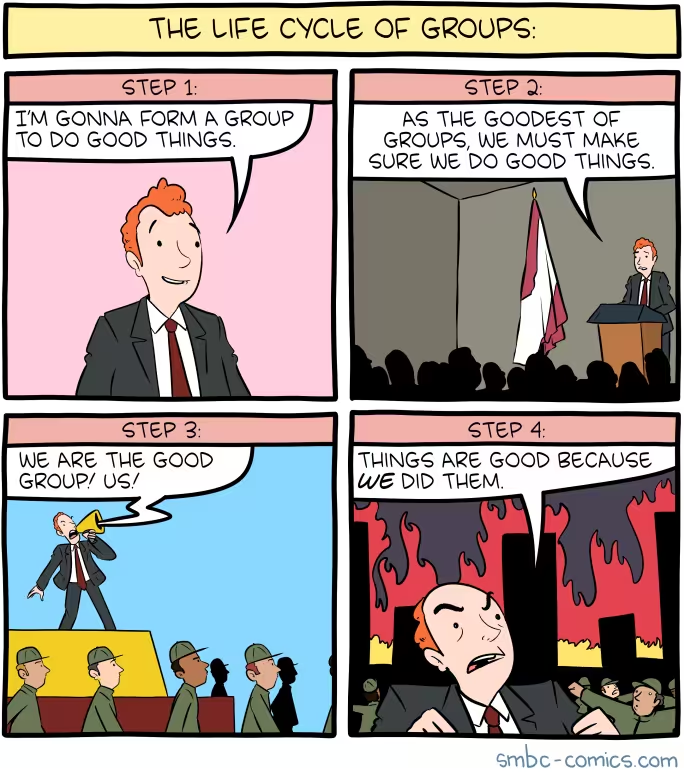Bureaucracy
The theory of Iron Laws and Moral Mazes
2020-02-02 — 2024-11-24
Wherein the slow calculus of offices is surveyed, and the deferred repair of a coking battery is shown to cause far greater collapse, legal penalty, and expense than an earlier decisive investment would have averted.
Placeholder. For consideration of: Moral Mazes, principal-agent problems, collective action problems, Vast Bureaucracies and other failure modes of institutional alignment in large, modern organizations.
1 Analysis
Zvi’s Moral mazes summary:
What has made these mazes so much more powerful than in the past?
Some factors are real and inevitable. We need more large organizations for our civilization to function than prior civilizations did, and in many ways, they better leverage big data, machine learning, and the internet, giving them an edge. As we grow safer and wealthier, our demand for the illusion of security rises, and mazes are relatively better positioned to provide that illusion.
There are many other reasons that are less real and less inevitable. We protect organizations from disruption, especially in times of crisis. We see rent-seeking of all kinds as increasingly legitimate. Mazes have gotten sufficiently powerful to cause a vicious cycle, as mazes reward and support other mazes and structure things to favour mazes. Our laws and regulations favour mazes over non-mazes, far beyond what is necessary due to civilizational complexity. Our educational system trains people for the maze, so much so that people have largely forgotten what mazes are and what the alternative to them might be. We have been so atomized, and their ordinary human needs so delegitimized, that we do not see what we are giving up.
What might we do to change things for the better? Regulatory reform, health care reform, tort reform, ending corporate welfare, or even forcibly breaking up large corporations would help. So would educating people on what mazes are and the dangers they pose, especially to their employees. We could work to change consumer behaviour, to lower the status and aura of legitimacy of mazes and those who work for them. And we could work to lower demand for the illusion of security.
For a given project, the best defence is to focus on the core elements, and thus do fewer things and be smaller, while minimizing interaction with other mazes. One should also seek separately to minimize levels of hierarchy, provide skin in the game and soul in the game, and be extremely careful with people. Hire, promote, evaluate, and fire them with a keen eye. Anyone making you more like a maze needs to go, no matter how painful that is. You must fight for your institutional culture.
It is hard to do quantitative research on self-preserving opaque power and easy to rant/speculate/complain, so there are a lot of essays on this theme with slightly different irreconcilable and dubiously verified models; but I think something is there.
Observations on these themes are not new; see Robert Michels’ 1911 Iron law of oligarchy.
Jackall’s own summary of Moral Mazes:
Consider the case of a large coking plant of the chemical company. Coke making requires a gigantic battery to cook the coke slowly and evenly for long periods; the battery is the most important piece of capital equipment in a coking plant. In 1975, the plant’s battery showed signs of weakening and certain managers at corporate headquarters had to decide whether to invest $6 million to restore the battery to top form. Clearly, because of the amount of money involved, this was a gut decision.
No decision was made. The CEO had sent the word out to defer all unnecessary capital expenditures to give the corporation cash reserves for other investments. So the managers allocated small amounts of money to patch the battery up until 1979, when it collapsed entirely. This brought the company into a breach of contract with a steel producer and into violation of various Environmental Protection Agency pollution regulations. The total bill, including lawsuits and now federally mandated repairs to the battery, exceeded $100 million. I have heard figures as high as $150 million, but because of “creative accounting,” no one is sure of the exact amount.
This simple but very typical example gets to the heart of how decision-making is intertwined with a company’s authority structure and advancement patterns. As the chemical company managers see it, the decisions facing them in 1975 and 1979 were crucially different. Had they acted decisively in 1975—in hindsight, the only rational course—they would have salvaged the battery and saved their corporation millions of dollars in the long run.
In the short run, however, since even seemingly rational decisions are subject to widely varying interpretations, particularly decisions which run counter to a CEO’s stated objectives, they would have been taking a serious risk in restoring the battery. What is more, their political networks might have unravelled, leaving them vulnerable to attack. They chose short-term safety over long-term gain because they felt they were judged, both by higher authority and by their peers, on their short-term performances. Managers feel that if they do not survive the short run, the long run hardly matters. Even correct decisions can shorten promising careers.
By contrast, in 1979 the decision was simple and posed little risk. The corporation had to meet its legal obligations; also it had to either repair the battery the way the EPA demanded or shut down the plant and lose several hundred million dollars. Since there were no real choices, everyone could agree on a course of action because everyone could appeal to inevitability. Diffusion of responsibility, in this case by procrastinating until total crisis, is intrinsic to organizational life because the real issue in most gut decisions is: Who is going to get blamed if things go wrong?
Connection: Moral mazes sound like the institutional equivalent of the subcultural problem analysed as Geeks, MOPs and Sociopaths.
Here are some more.
2 Invective
The Gervais principle, which divides people into archetypes: Sociopaths, Losers, and Clueless. The major dataset for this study is the American version of The Office, with all that entails. This model is fun to read but not to be taken too seriously.
Same category, maybe, is David Graeber’s theory of ‘bullshit jobs’:
It’s as if someone were out there making up pointless jobs just for the sake of keeping us all working. And here, precisely, lies the mystery. In capitalism, this is precisely what is not supposed to happen. Sure, in the old inefficient socialist states like the Soviet Union, where employment was considered both a right and a sacred duty, the system made up as many jobs as they had to (this is why in Soviet department stores it took three clerks to sell a piece of meat). But, of course, this is the sort of very problem market competition is supposed to fix. According to economic theory, at least, the last thing a profit-seeking firm is going to do is shell out money to workers they don’t really need to employ. Still, somehow, it happens.
Nation of Slaves is Charles Stross’s employment-obsession rhetoric:
There are two tests I’d apply to any job when deciding whether it’s what anthropologist David Graeber terms a Bullshit Job.
Test (a): Is it good for you (the worker)?
Test (b): Is it good for other people? […]
When he prescribes full employment for the population, what he’s actually asking for is that the proles get out of his hair; that one of his peers’ corporations finds a use for idle hands that would otherwise be subsisting on Jobseekers Allowance but which can now be coopted, via the miracle of workfare, into producing something for very little at all. And by using the threat of workfare, real world wages can be negotiated down and down and down, until labour is cheap enough that any taskmaster who cares to crack the whip can afford as much as they need. These aren’t jobs that pass test (a); for the most part they don’t pass test (b) either. But until we come up with a better way of allocating resources so that all may eat, or until we throw off the shackles of Orwellian Crimestop and teach ourselves to think directly about the implications of wasting a third of our waking lives on occupations that harm ourselves and others, this is what we’re stuck with …
There is a whole spin-off book about bullshit jobs now, although I have not read it, just the original article.
The invective is fun, like the Peter Principle or one of those other semi-humorous texts that self-classified renegades like to imagine is the problem with those pencil-pushers at the office. I find the helpfulness limited; this feels like a symptomatic treatment of a systemic problem.
Clay Shirky, The Collapse of Complex Business Models:
Bureaucracies temporarily suspend the Second Law of Thermodynamics. In a bureaucracy, it’s easier to make a process more complex than to make it simpler, and easier to create a new burden than kill an old one.
3 The Shirky principle
The Shirky Principle: “Institutions will try to preserve the problem to which they are the solution.”
See
I have seen this happening, but I doubt it is so very frequent. Institutions themselves do not usually have the leverage. Industry lobby groups have more success at preserving problems that prop up their members’ business models, and I see a lot of that.
4 Ameliorating
See Navigating large organizations.
5 Incoming
Do organizations have to get slower as they grow? (with Alex Komoroske)
Yes, You Can Eliminate Bureaucracy
…the most promising solution may have emerged in an unlikely place: the world’s largest appliance maker, Haier. Under a renegade CEO, it has been divided into 4,000 self-managing microenterprises. About 250 are market facing (“users”), and the rest (“nodes”) supply them with components and services like IT and HR support. Users can hire and fire nodes—or contract with outside providers—as they see fit, and nodes’ revenues are tied to their users’ success.



